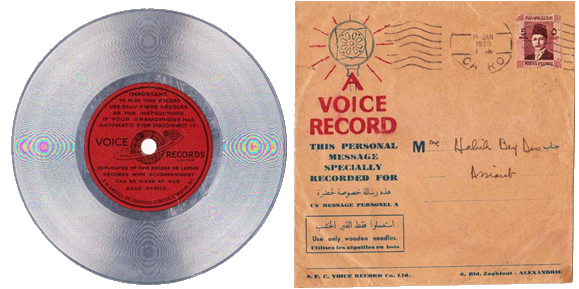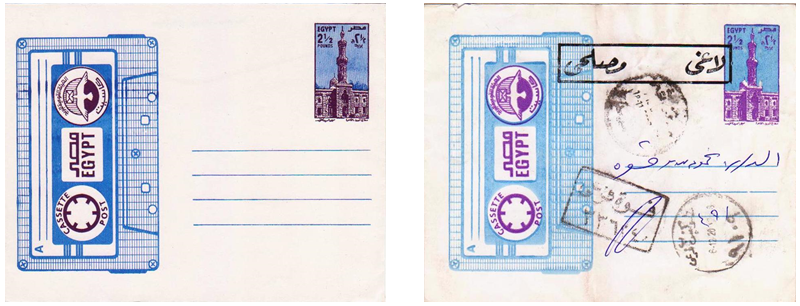PRESENT: Twelve members attended; apologies for absence were received from eight members.
Our November meeting occurred in close proximity to Guy Fawkes' Night, and there were certainly fireworks aplenty from our two speakers - Lucien Toutounji (ESC 264) on the EEF Aerial Posts of 1919, and Peter Andrews (ESC 122) on the intriguing Cassette Envelopes postal stationery.
 The four unframed Aerial Post cachets identified by Lucien Toutounji
The four unframed Aerial Post cachets identified by Lucien Toutounji
We were delighted to see Lucien's display, a section of his international Gold medal exhibition of Egyptian Early Airmails from 1910-36, which opened with a tiny history lesson, on the exile to Malta of Saad Zaghloul, revolutionary leader of the Wafd Party, the consequent increase in violence against the British, and consequent on that, a major influx of British troops into Egypt and Palestine at a time before efficient postal services had been fixed.
The RAF established an airmail service between Alexandria, Cairo, Suez and the Canal Zone and Palestine which started on March 17, 1919, and ended on May 3 the same year, when Zaghloul was released. Lucien is proud of the fact that he it was who established the four different types of unframed Aerial Post cachet as used from Alexandria from March 20 to April 3: he estimates that about 45 covers are believed to exist, about 15 of them addressed to Palestine.
Others went to centres within Egypt, and to India - and Lucien showed an astonishing cover addressed to Mombasa, which was misdirected to Palestine, readdressed, and finally returned from Dar es-Salaam.
 At the same time Cairo was using a large circular cachet datestamp, of which only 15 covers are known. Lucien showed a first-day cover (March 18) to Jerusalem, as well as another sent from Alexandria to Cairo and returned, thus receiving both air cachets on the same cover (below).
At the same time Cairo was using a large circular cachet datestamp, of which only 15 covers are known. Lucien showed a first-day cover (March 18) to Jerusalem, as well as another sent from Alexandria to Cairo and returned, thus receiving both air cachets on the same cover (below).
On April 5 Alexandria switched to a cachet set inside a bold black rectangle, in use until May 1 - we were able to see the only example recorded to Beirut - and Cairo used the same cachet but in violet. Here we were shown the only "civilian" usage, on a cover with OHMS crossed through, dated April 10 from Cairo via Alexandria to France. Some 30 covers are known from Alexandria and 25 from Cairo.
John Sears, who showed a Palestine News cover dated March 18 with the EEF cachet, thanked Lucien for his outstanding display, and said that he owed him a vote of thanks, for Lucien's thanks when John presented Air Mails some 15 years ago.
Lucien was also involved in the second talk, for, as Peter Andrews explained, our first mention of Cassette Envelopes came in a brief QC note announcing a Post Office advertisement for them - submitted by one L. Toutounji of Cairo.
Peter surprised us all by opening his display with a forerunner - actually, a disk and accompanying envelope sent to Habib Bey Doss in Asyut from Cairo on January 19, 1939, on which a recording could be made and then mailed anywhere in the world - "use only wooden needles", the envelope says. The enterprising company setting up this service was SFV Voice Record Co of Alexandria.

From there, jump forward to December 1989 (probably - there is MUCH discussion and confusion about issue dates and none at all on printing numbers), when the Egyptian Post Office published an envelope printed on stout white paper to carry audio cassettes on behalf of those unable to read or write. The sender had to approach the service desk with cassette and envelope for the clerk to address it for him.
 Identified by the large illustration of a cassette and a printed "stamp" vignette, the initial envelope had a face value of £E1, presumably for internal usage, but there quickly followed a £E2 value in different colours, and then a £E2 ½ value, which is probably the longest-lasting of the whole series.
Identified by the large illustration of a cassette and a printed "stamp" vignette, the initial envelope had a face value of £E1, presumably for internal usage, but there quickly followed a £E2 value in different colours, and then a £E2 ½ value, which is probably the longest-lasting of the whole series.
It is understood that all were treated as registered mail, and although the series ran through values of £E3 ½ to £E4 - Peter tried manfully to trace dates of issue and of usage, but "first day covers" proved unreliable, and because of the nature of the contents used envelopes are often so badly damaged that dates cannot easily be read. In addition, extra stamps were often used, indicating that the printed versions did not keep up with the postage rates, though these are often in better condition, showing that they had never carried a cassette!
The long-lived £E2 ½ issue, left, and cancelled and used by the Post Office in December 2007
The varieties of value, colour, flap type, placing of address lines in relation to the vignette, reverse text, under-flap text etc etc are mind-boggling. Peter showed a letter from the National Postal Organisation informing Michael Barker that the first envelopes were issued in 1991; but we have FDCs (of the £E2 value) for December 1 1989. There is little information and no consistency. What is consistent is that early types show vertical stamp vignettes of mosques, then short mosques, and later ones with ancient Egyptian figures.
It seems that the service was discontinued probably in about 2000, and surplus covers - it is difficult to gauge the actual use for the purpose intended - were given rough overprints of the Arabic words for "Cancelled" and "Official", and these are now found used between post offices presumably on official business.
Pater's gargantuan task of following this flurry of issues was much appreciated by an audience many of whom were seeing such items for the first time. The speaker was thanked for his patience and members showed their grateful appreciation.
John Davis (ESC 213) then took a moment to explain that the first volume of his three-part book on the Postal Concessionary period was close to completion; details can be had direct from John.
Earlier members had welcomes Nabil Guirguis (ESC 670) to his first meeting, and the Secretary had reminded members that all will be asked to make a choice of receiving a printed version of the QC or reading it (and printing out if need be) online. Those who choose the latter option will pay a reduced subscription of £15 for 2015; those who do not choose will stay at the £20 rate.
The meetings list for 2015 was published, with one meeting off-site (just) at the May Europhilex exhibition in Islington - it was impossible to hire a room, so we have accepted the kind offer of a room in the Premier Inn just across the road.
John Clarke (ESC 497) ran the mini-auction in the absence of Jon Aitchison, and successful bidding led to a commission for the Circle of £17.20. Thank you to all those who contributed.
|

